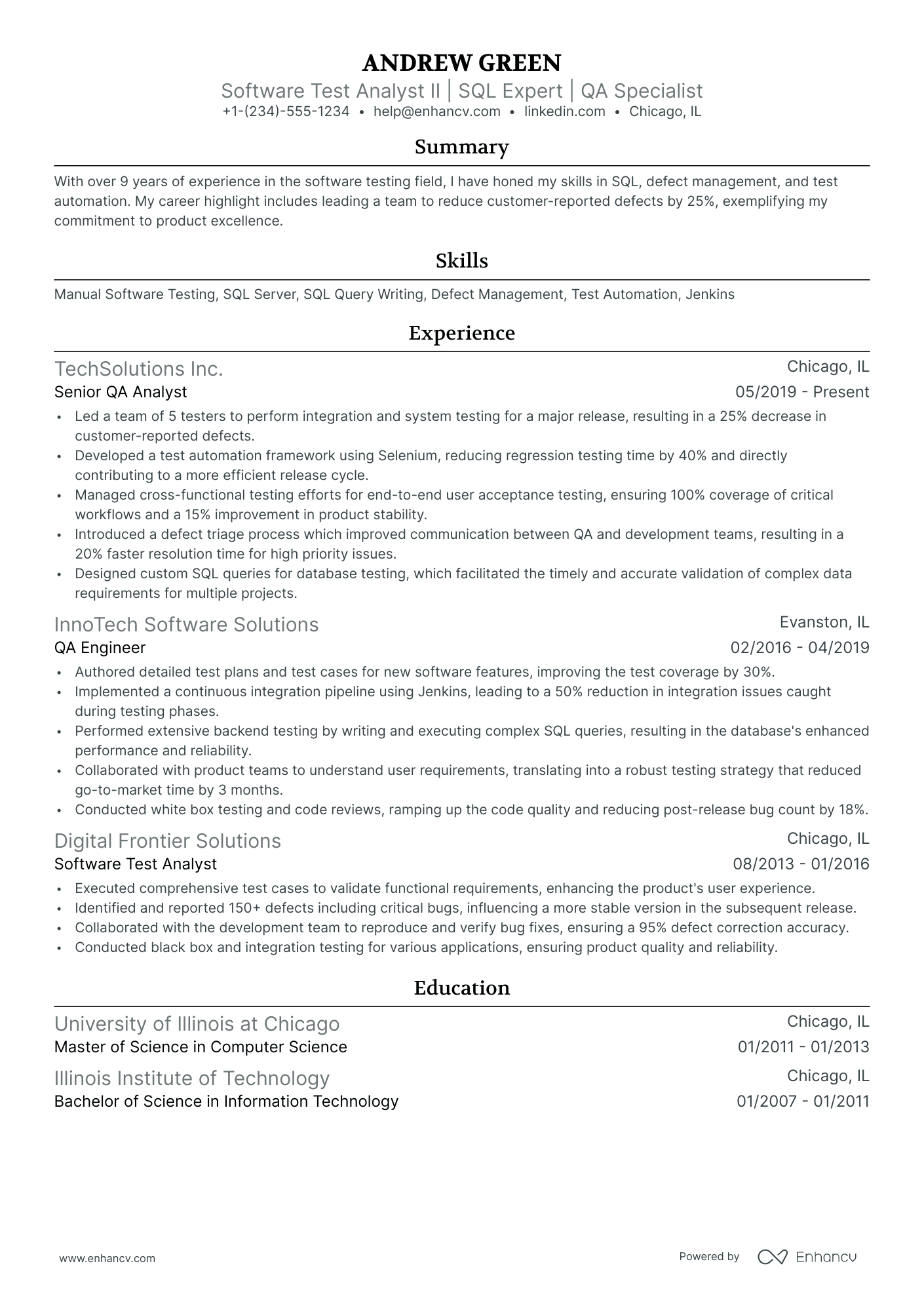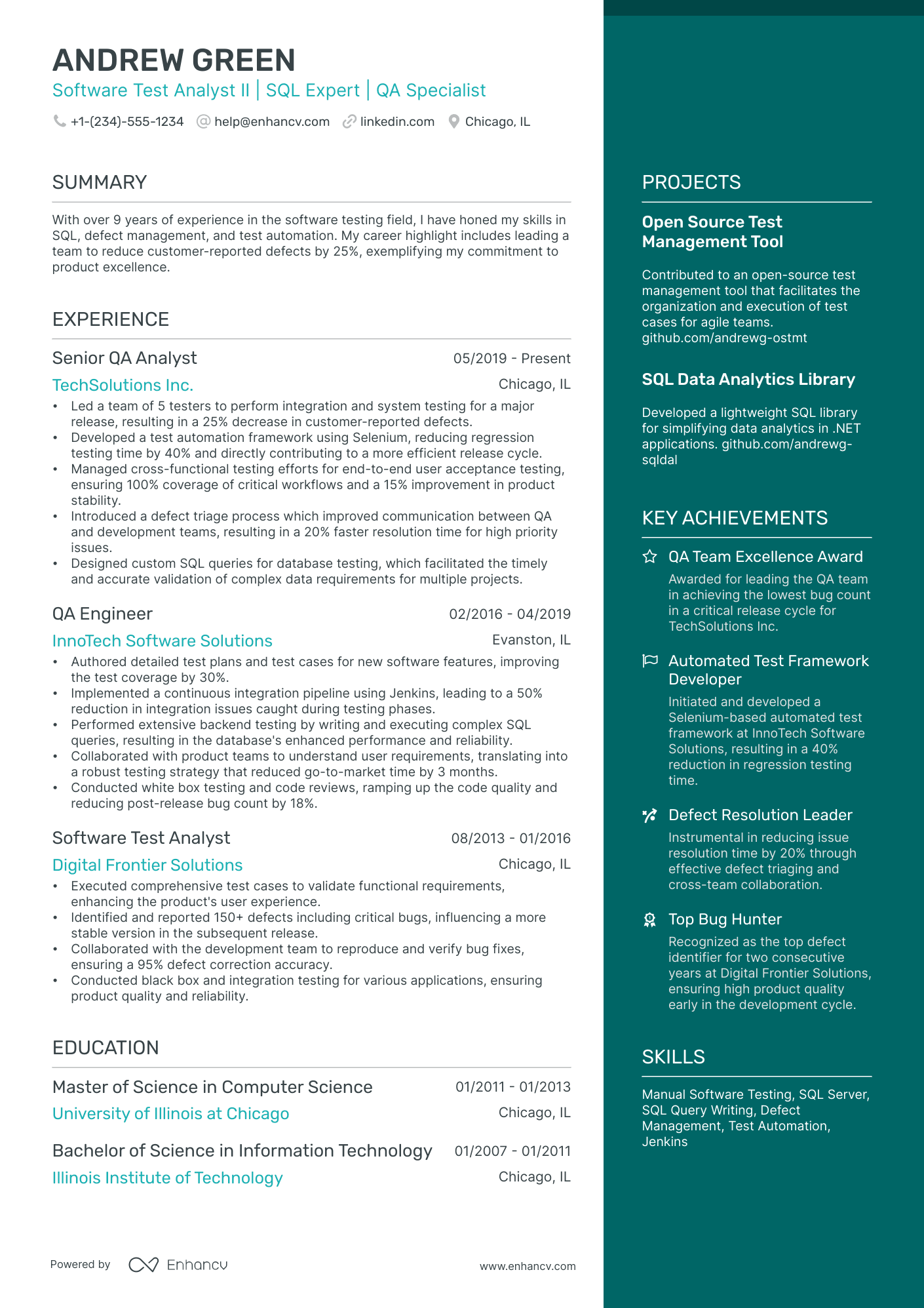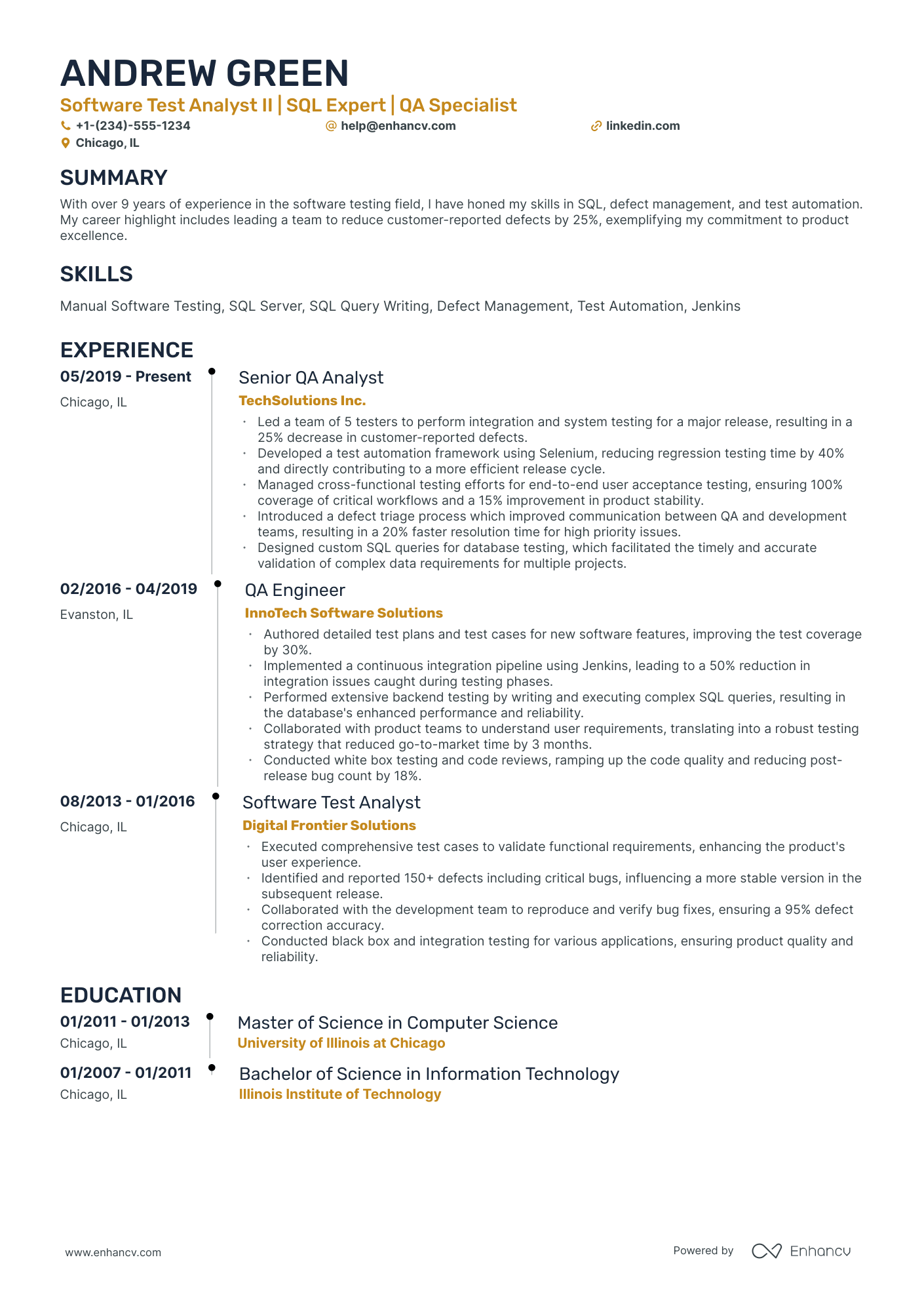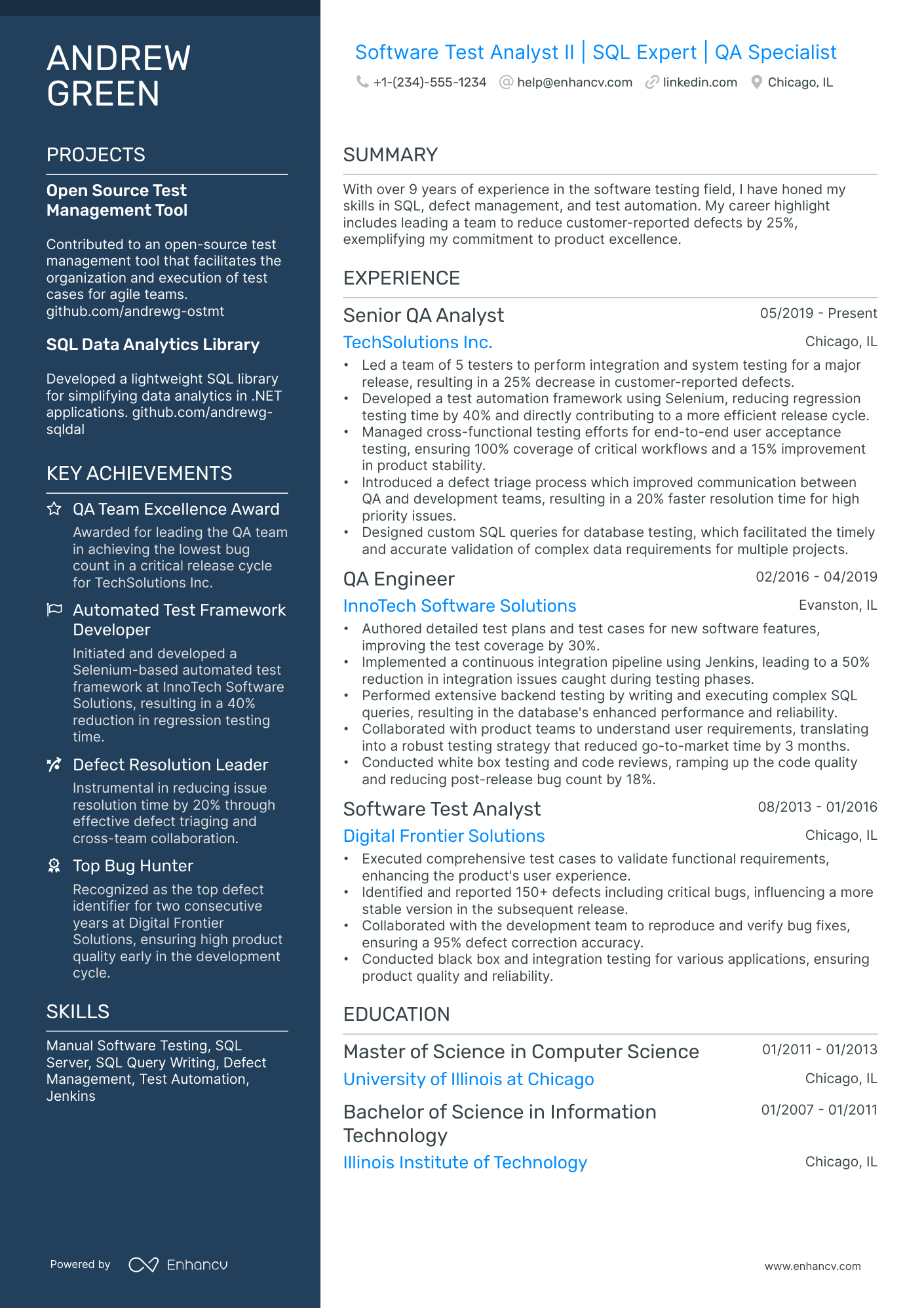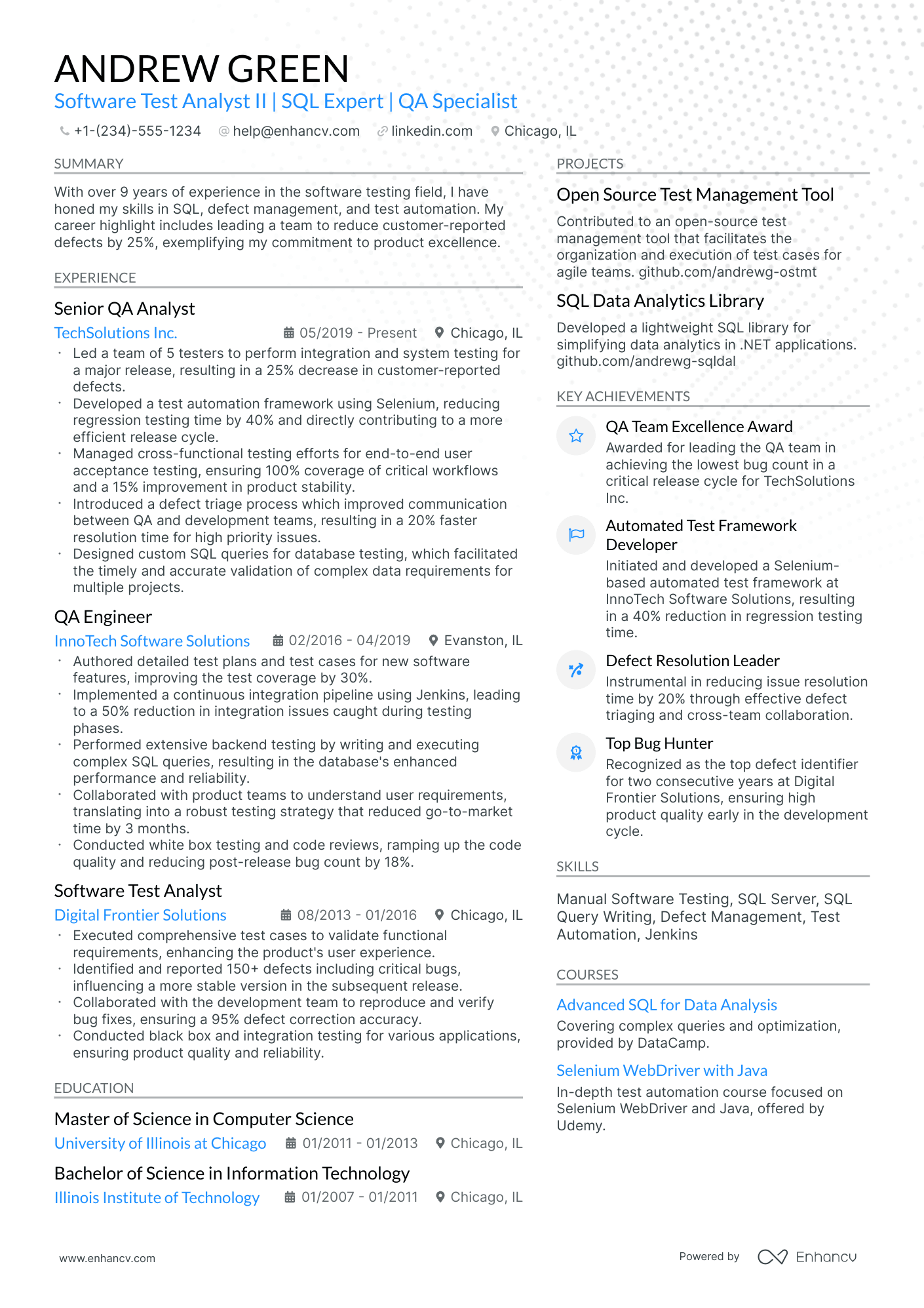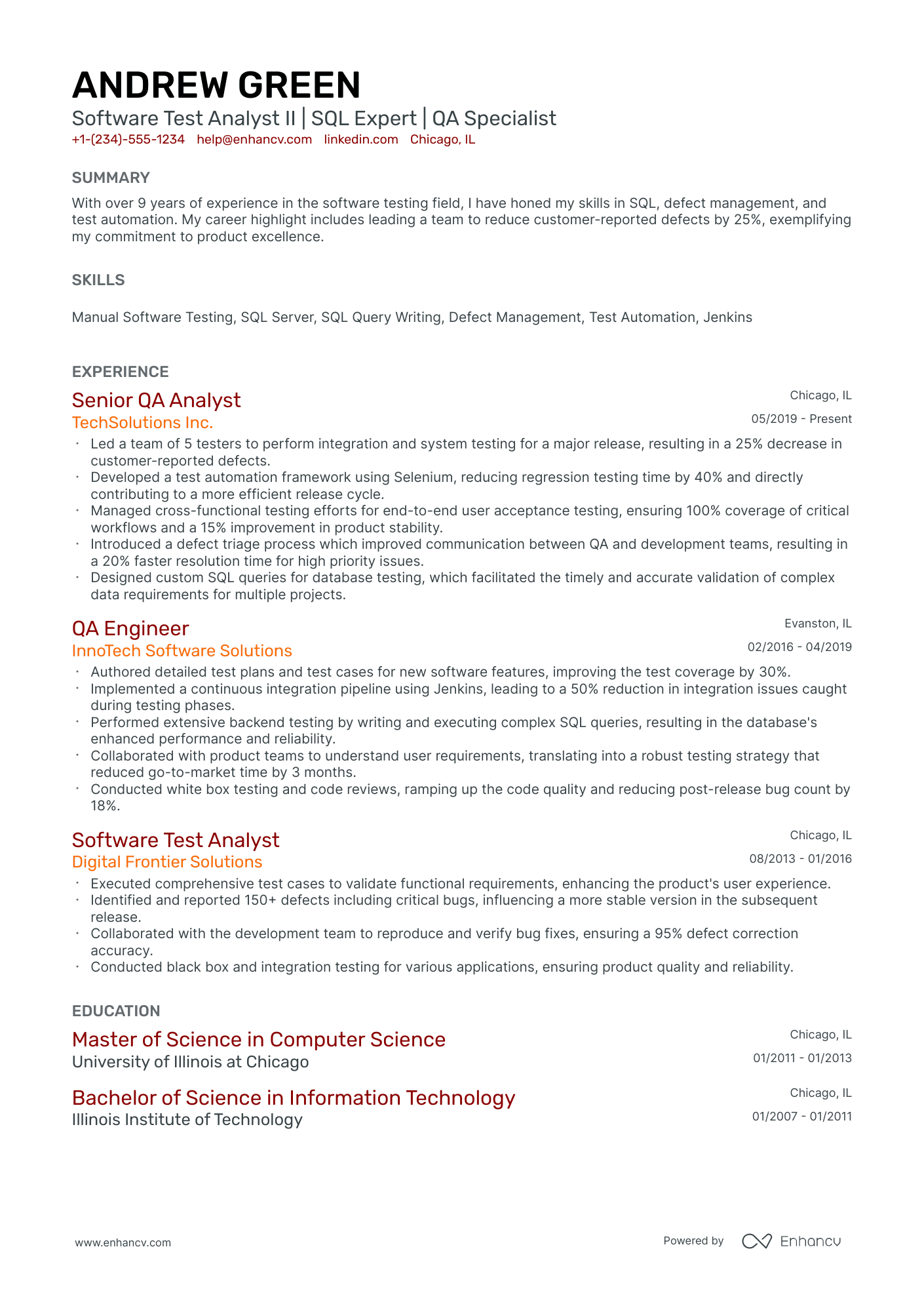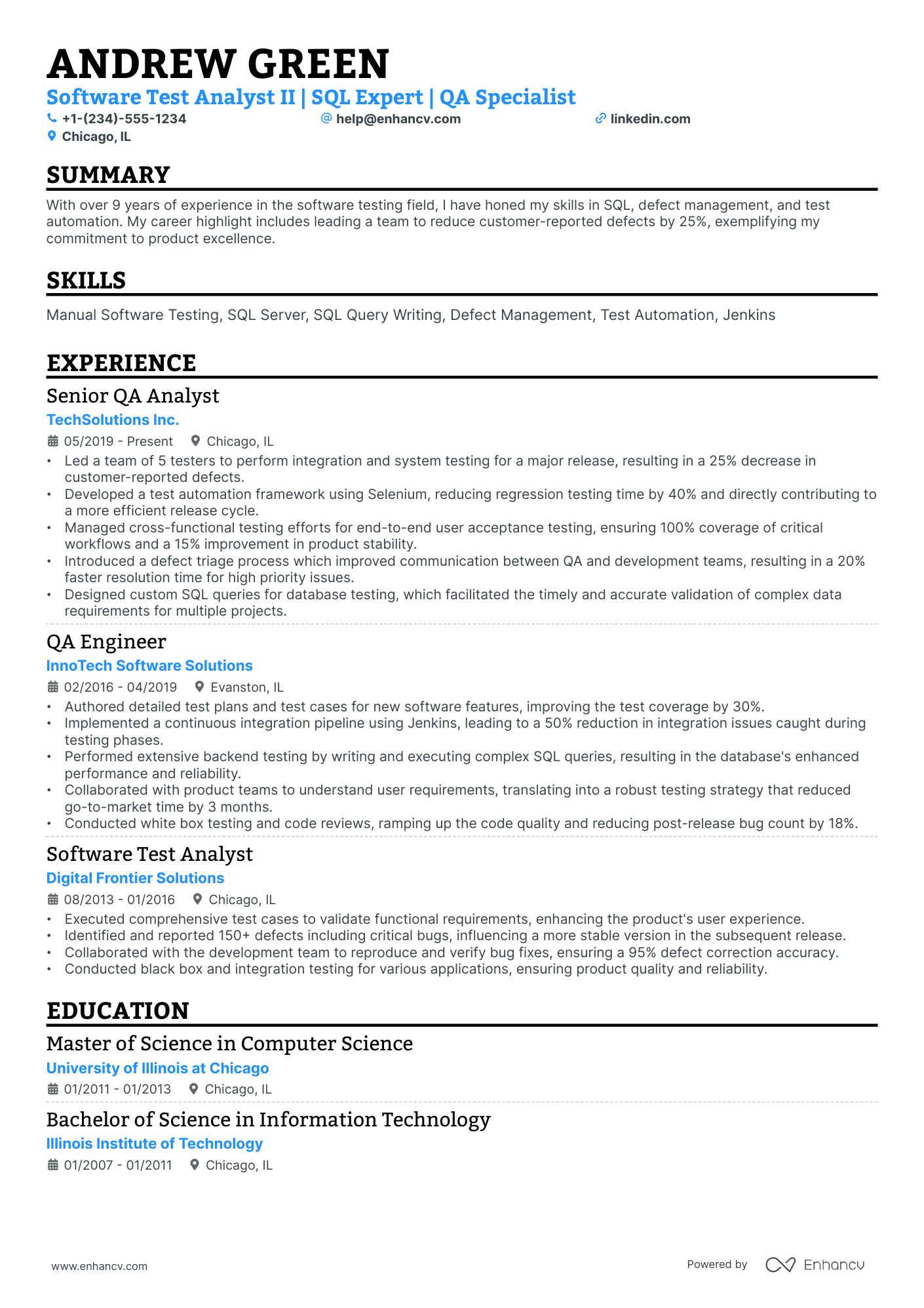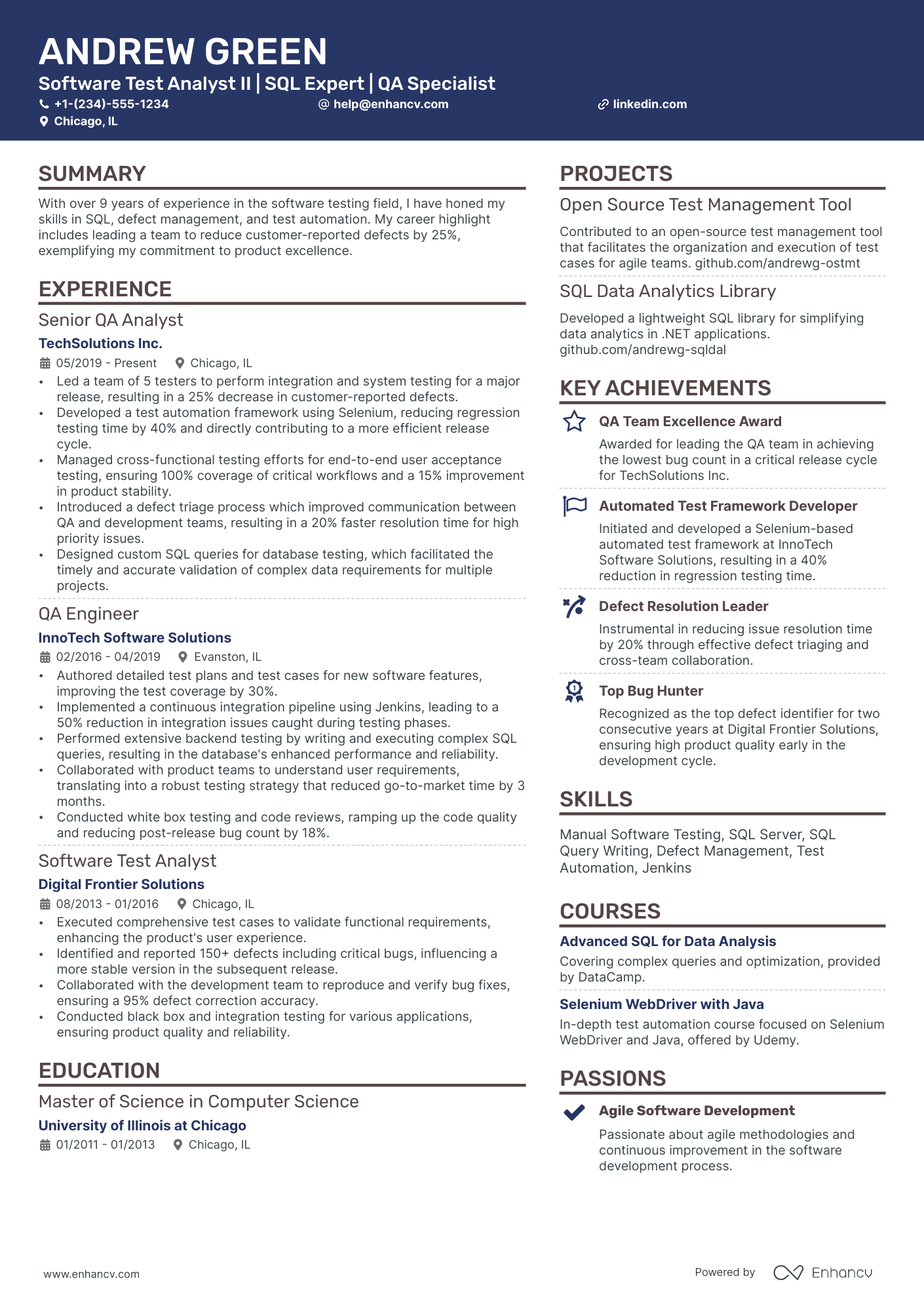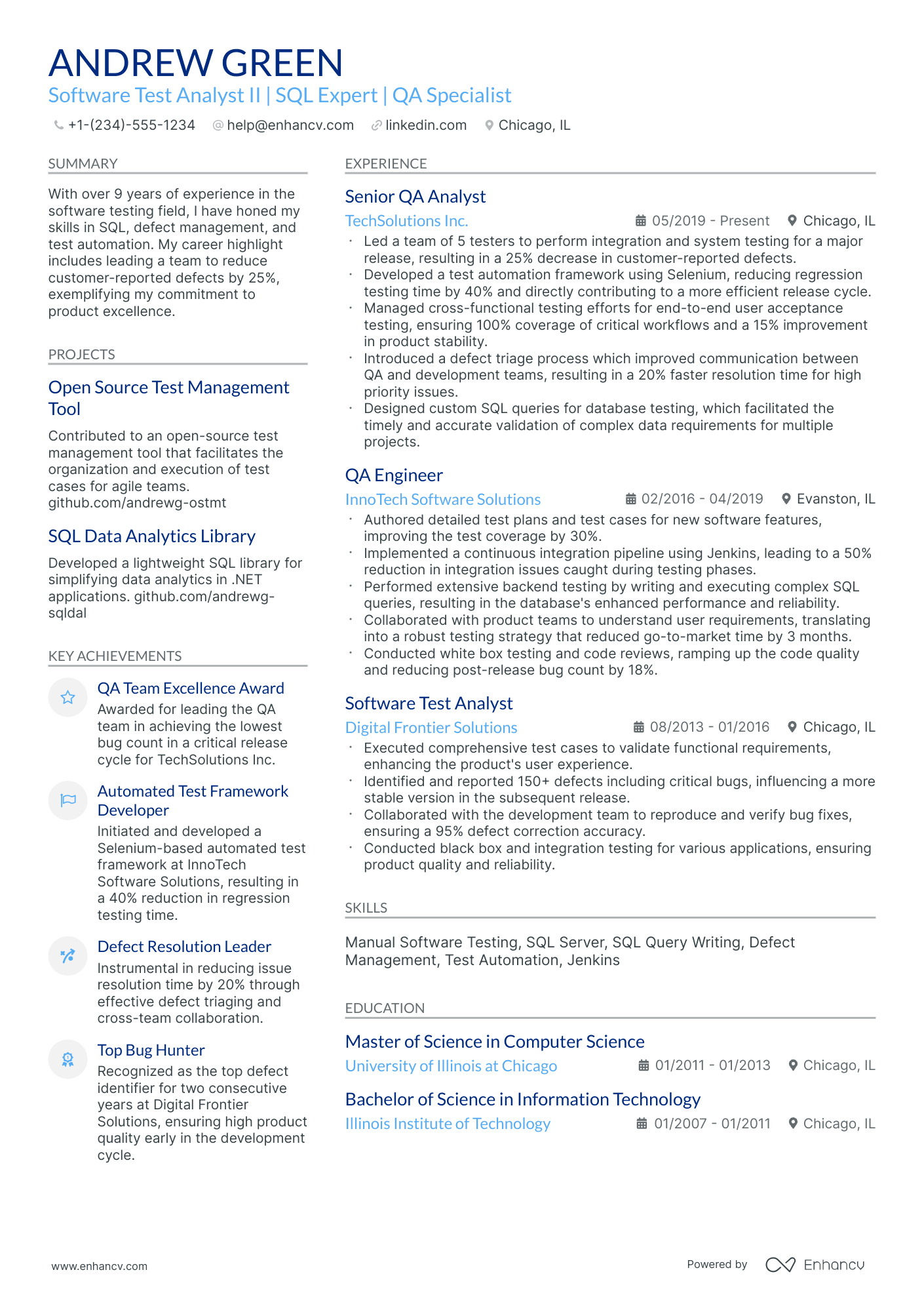As a software test analyst, one resume challenge you might encounter is effectively showcasing both your technical expertise and your experience in various testing methodologies. Our guide can help you navigate this challenge by offering strategies to balance technical jargon with clear descriptions, ensuring recruiters recognize the breadth of your skill set and your proficiency in the field.
- Defining the highlights of your software test analyst career through your resume summary, objective, and experience.
- Real-world software test analyst resume samples with best practices on how to stand out amongst the endless pile of candidate resumes.
- Most in-demand software test analyst resume skills and certifications across the industry.
- Standardizing your resume layout, while maintaining your creativity and individuality.
If the software test analyst resume isn't the right one for you, take a look at other related guides we have:
- Software Developer Resume Example
- Mobile Application Developer Resume Example
- Cobol Developer Resume Example
- Content Developer Resume Example
- Senior Oracle Developer Resume Example
- J2EE Developer Resume Example
- Java Software Engineer Resume Example
- Senior Web Developer Resume Example
- SAP Abap Developer Resume Example
- Ruby On Rails Developer Resume Example
Creating the best software test analyst resume format: four simple steps
The most appropriate software test analyst resume format is defined by precision and a systematic approach. What is more, it should reflect upon how your application will be assessed by recruiters. That is why we've gathered four of the most vital elements to keep in mind when designing your resume:
- It's all about presenting how your experience or skills align with the job. Use the reverse-chronological resume format , if your expertise is relevant to the software test analyst role. Otherwise, select the functional skill-based resume format or the hybrid resume format to shift the focus to your skill set.
- Resume header - make sure you've filled out all relevant (and correct) information, like your contact details and link to your portfolio.
- Resume length - unless you've over a decade of applicable expertise in the field, stick with a one-page resume format. If you'd like to present more of your professional experience, go up to two pages.
- Resume file - submit your software test analyst resume in a PDF format to ensure all information stays in the same place.
Think about the market’s preferences – a Canadian resume, for instance, could have a different layout.
Upload & Check Your Resume
Drop your resume here or choose a file. PDF & DOCX only. Max 2MB file size.
PRO TIP
If the certificate you've obtained is especially vital for the industry or company, include it as part of your name within the resume headline.
The five (plus) definite sections your resume for a software test analyst job should include are:
- Header with your headline, contact details, and/or a preview of your work
- Summary (or objective) to pinpoint how your success aligns with the role
- Experience with bullets of your most relevant achievements in the field
- Skills to integrate vital job requirements (both technical and personal)
- Your further dedication to the field, showcased via relevant higher education and/or certifications
What recruiters want to see on your resume:
- Well-documented experience with various testing methodologies (e.g., manual, automated, regression, UAT).
- Proficiency in test management software and QA tools (e.g., JIRA, TestRail, Selenium, QTP).
- Demonstrated skill in creating detailed test cases, test plans, and reports.
- Experience with different software development life cycles (SDLC), including Agile and Waterfall methodologies.
- Strong analytical and problem-solving skills, with a keen attention to detail for identifying and recording bugs.
Quick guide to your software test analyst resume experience section
After deciding on the format of your resume, it's time to organize your experience within the dedicated section.
It's common for software test analyst professionals to be confused in this part of the process, as they may have too much or little expertise.
Follow the general rules of thumb to be successful when writing this part of your resume:
- The perfect number of bullets you should have under each experience item is no more than six;
- Select not merely your responsibilities, but the most noteworthy achievements for each role that match the job requirements;
- List any certificates or technical expertise you've gained on the job and how they've helped you progress as a professional;
- Carefully select the power verbs to go along with each bullet to avoid generic ones like "managed" and instead substitute those with the actuality of your particular responsibility;
- Integrate valuable keywords from the job advert in the form of achievements under each role you list.
If you're on the search for further advice on how to write your software test analyst experience section, get some ideas from real-world professional resumes:
- Led a software testing team through the successful release cycle of a major product, resulting in a 30% reduction in post-deployment issues and a subsequent increase in customer satisfaction.
- Designed and implemented a comprehensive test automation strategy with Selenium WebDriver, increasing test coverage by 40% and reducing manual testing efforts by 60%.
- Actively collaborated with cross-functional teams to integrate user-centric testing methodologies, enhancing product usability and driving a 15% improvement in user retention rates.
- Orchestrated the adoption of Agile testing methodologies, resulting in a 20% acceleration in testing cycles and earlier identification of critical defects.
- Conducted thorough system, integration, and performance testing, identifying and logging over 200 bugs, greatly improving the final product's reliability.
- Provided mentorship to junior analysts, enhancing the overall skill set of the team and contributing to a culture of continual learning and improvement.
- Initiated the development of new testing frameworks for mobile applications, shortening the test cycle by 25% through automation.
- Managed a portfolio of test cases for a large-scale client management system, ensuring regulatory compliance and operational efficiency.
- Performed risk-based testing to prioritize the most crucial features and functions, significantly reducing potential system vulnerabilities.
- Pioneered the implementation of a CI/CD pipeline incorporating automated tests, which boosted deployment frequency by 50%.
- Executed an extensive backend testing program for a financial service platform, enhancing transaction processing speed by 35%.
- Fostered a collaborative environment with the development team to ensure a 'test early, test often' mindset, minimizing late-stage defect discovery.
- Streamlined data-driven test case management, contributing to a 20% improvement in test execution time.
- Developed and executed test protocols for security software, reducing the threat detection time by 22% and enhancing user data protection.
- Revamped existing testing suites to accommodate for new application features, maintaining 100% test effectiveness during consecutive release cycles.
- Implemented a scalable test automation framework from the ground up, supporting a 300% increase in product offerings.
- Guided the team toward a 99.5% defect detection efficiency rate by refining test case creation and validation processes.
- Contributed to cross-departmental meetings to align testing objectives with business goals, maximizing the return on investment for testing activities.
- Optimized application performance by identifying bottlenecks through load testing, enhancing load capacity by over 40% without loss of functionality.
- Instrumental in the transition to cloud-based testing environments, reducing infrastructure costs by 25% while maintaining a seamless workflow.
- Led a project to standardize defect reporting across all testing platforms, dramatically reducing miscommunication and improving repair times by 30%.
- Accelerated time-to-market by 20% through the strategic optimization of testing processes and elimination of redundant test cases.
- Effectively managed a team of software testers in a project that involved the successful delivery of a complex CRM system.
- Developed customized testing solutions for emerging technologies within the company, ensuring scalability and support for future growth.
- Spearheaded a project that achieved a test automation coverage milestone of 80%, significantly reducing the risk of human error.
- Enhanced the end-user experience by conducting meticulous usability testing, leading to a user interface overhaul that boosted conversion rates by 18%.
- Collaborated with software developers to integrate unit tests, reducing defect carryover into production by 50%.
- Overhauled regression testing suite, which resulted in a 25% speed increase in the release validation process without compromising on quality standards.
- Played a key role in the integration of performance testing within the SDLC, cutting down post-release performance complaints by 60%.
- Championed the implementation of a centralized test case repository, improving test asset reuse and decreasing time spent on test design by 30%.
The following content includes information from "O*NET OnLine" by the U.S. Department of Labor, Employment and Training Administration (USDOL/ETA). Used under the CC BY 4.0 license. The data represents the top responsibilities present on the task lists for software test analyst professionals.
Top Responsibilities for Software Test Analyst:
- Identify, analyze, and document problems with program function, output, online screen, or content.
- Document software defects, using a bug tracking system, and report defects to software developers.
- Develop testing programs that address areas such as database impacts, software scenarios, regression testing, negative testing, error or bug retests, or usability.
- Design test plans, scenarios, scripts, or procedures.
- Document test procedures to ensure replicability and compliance with standards.
- Provide feedback and recommendations to developers on software usability and functionality.
- Install, maintain, or use software testing programs.
- Test system modifications to prepare for implementation.
- Create or maintain databases of known test defects.
- Develop or specify standards, methods, or procedures to determine product quality or release readiness.
Quantifying impact on your resume
- Quantify the number of test cases designed and executed to demonstrate proficiency in test planning and execution.
- Highlight the percentage of defects found in the software before release to showcase effectiveness in defect identification.
- Indicate the number of automated tests written and maintained to emphasize skills in test automation.
- Detail the reduction in test cycle time due to optimizations made, showing efficiency in test process improvement.
- Specify the increase in test coverage achieved, illustrating commitment to thorough quality assurance.
- Present the number of successful projects delivered by following strict quality standards to reflect project management capabilities.
- Mention the percentage of test scenarios that match real-world usage to demonstrate user-centric testing approach.
- State the amount of cost savings realized by identifying and resolving issues early in the software development lifecycle.
Action verbs for your software test analyst resume
Software test analyst resume without experience: a walk-through guide
If you don't happen to have any relevant experience yet, you can substitute this with:
- Short-term gigs and stunts - like month-long internships, that you have done during your university days
- Contract work - be specific about the relevance and outcomes of each role you include
- Resume format that prioritizes your skills - the functional-skill-based format or hybrid format could work
- Research roles - feature those especially prominently if you've participated in a noteworthy project or your role was of utmost importance to the project's success.
Recommended reads:
PRO TIP
If you're in the process of obtaining your certificate or degree, list the expected date you're supposed to graduate or be certified.
Popular software test analyst hard skills and soft skills for your resume
Apart from assessing your professional expertise, recruiters are on the lookout for whether your skills align with the job.
Your profile would thus be assessed in regard to your:
- Hard or technical skills - your ability to perform on the job using particular technologies or software
- Soft skills - how you adapt, communicate, and thrive in different environments.
Both types of skills - hard and soft skills - are important for your resume, so make sure to create a dedicated skills section that:
- Lists up to five or six skills that align with the job advert.
- Integrates vital keywords for the industry, but also reflects on your personal strengths.
- Builds up further your skills with an achievements section within which you explain what you've achieved thanks to using the particular skill.
- Aims to always quantify in some way how you've used the skill, as it's not enough to just list it.
What are the most sought out hard and soft skills for software test analyst roles?
Check out the industry's top choices with our two dedicated lists below:
Top skills for your software test analyst resume:
Selenium
JUnit
TestNG
Postman
JIRA
SQL
Python
API Testing
Automation Frameworks
Load Testing Tools
Analytical Thinking
Attention to Detail
Problem-Solving
Communication
Collaboration
Time Management
Adaptability
Critical Thinking
Creativity
Empathy
Next, you will find information on the top technologies for software test analyst professonals from "O*NET OnLine" by the U.S. Department of Labor, Employment and Training Administration (USDOL/ETA). Used under the CC BY 4.0 license.
Top technologies for Software Test Analyst’s resume:
- Apache Subversion SVN
- Oracle Java 2 Platform Enterprise Edition J2EE
- Apache Hive
- Blackboard software
- JUnit
- Selenium
PRO TIP
If you failed to obtain one of the certificates, as listed in the requirements, but decide to include it on your resume, make sure to include a note somewhere that you have the "relevant training, but are planning to re-take the exams". Support this statement with the actual date you're planning to be re-examined. Always be honest on your resume.
Showcase academic background with education and certifications' sections
Listing your education and certifications should be a rudimentary part of your resume writing.
Including your relevant academic background - in the form of your higher education degree and niche-specific certificates - will prove knowledge of the industry.
For your education section:
- Start by including your degree, followed by start and graduation dates, as well as the institution;
- You could include relevant coursework, major/minor , or GPA, only if your've just graduated from college or if this information would further support your application;
- If you have an "ongoing" degree, you can still list it in case you think your diploma can impress recruiters or it's required;
Follow a similar logic for your certifications section by listing the institution, alongside dates you've obtained the certificate. For some of the most recent and relevant industry certificates , check out the next part of our guide:
The top 5 certifications for your software test analyst resume:
- Certified Software Tester (CSTE) - QAI Global Institute
- International Software Testing Qualifications Board Certified Tester (ISTQB CTFL) - International Software Testing Qualifications Board
- Advanced Test Manager (CTAL-TM) - International Software Testing Qualifications Board
- Certified Software Test Engineer (CSTE) - International Institute for Software Testing
- ASTQB Mobile Testing Certification (ASTQB MTC) - American Software Testing Qualifications Board
The content below includes information from "O*NET OnLine" by the U.S. Department of Labor, Employment and Training Administration (USDOL/ETA). Used under the CC BY 4.0 license. The data represents the top associations for software test analyst professionals.
Top US associations for a Software Test Analyst professional
- American Software Testing Qualifications Board
- Association for Testing and Software Quality Assurance
- American Society for Quality
- Association for Computing Machinery
- CompTIA
PRO TIP
Highlight any significant extracurricular activities that demonstrate valuable skills or leadership.
Recommended reads:
Deciding between a resume summary or objective for your software test analyst role
Understanding the distinction between a resume summary and an objective is crucial for your software test analyst resume.
A resume summary, typically three to five sentences long, offers a concise overview of your career. This is the place to showcase your most pertinent experience, key accomplishments, and skills. It's particularly well-suited for those with professional experience relevant to the job requirements.
In contrast, a resume objective focuses on how you can add value to potential employers. It addresses why they should hire you and outlines your career expectations and learning goals. Therefore, it's ideal for candidates with less experience.
In the following section of our guide, explore how resume summaries and objectives differ through some exemplary industry-specific examples.
Resume summaries for a software test analyst job
- Accomplished software test analyst with over 6 years of experience in the tech sector. Expertise in automated testing tools such as Selenium and QTP, coupled with a deep understanding of Agile methodologies. Recognized for improving test coverage by 40% at TechGenix, demonstrating a keen eye for detecting and resolving software anomalies.
- Seasoned QA professional transitioning to a software test analyst role, bringing 8 years of extensive experience in high-pressure defense systems testing. Proficient with manual testing processes and eager to enhance software reliability by applying rigorous testing standards learned from safety-critical system verification.
- Former network engineer eager to leverage 5 years of troubleshooting and configuration experience with a passion for quality assurance in a software test analyst capacity. Highly skilled in network protocols and communication software, aiming to apply precise analytic skills to ensure software integrity and robustness.
- Detail-oriented software test analyst with a track record of success in 7 years of service at a leading e-commerce company, adept in process improvement and defect tracking using JIRA. Successfully led a cross-functional team in a project that boosted software release efficiency by 30%.
- Aspiring software test analyst committed to learning cutting-edge testing techniques and contributing to high-quality software development. Objective: To apply my robust analytical skills, procedural knowledge learned from my Bachelor’s in Computer Science, and passion for tech innovation to the complex challenges of software testing.
- Goal-driven individual with a strong academic foundation in software engineering, aiming to establish a career in software testing. Objective: To offer my proficiency in Java, Python, and unit testing, honed through my recent internship, by identifying and mitigating defects, ensuring software performs to its highest standard.
Average salary info by state in the US for software test analyst professionals
Local salary info for Software Test Analyst.” Source: My Next Move, National Center for O*NET Development. Accessed 10/15/2024
| State | Average Salary (in USD) |
|---|---|
| US National Average | $101,800 |
| California (CA) | $129,400 |
| Texas (TX) | $100,230 |
| Florida (FL) | $95,690 |
| New York (NY) | $111,750 |
| Pennsylvania (PA) | $91,240 |
| Illinois (IL) | $92,520 |
| Ohio (OH) | $82,550 |
| Georgia (GA) | $98,820 |
| North Carolina (NC) | $99,320 |
| Michigan (MI) | $82,950 |
Beyond your software test analyst resume basics - extra sections
Ensure your software test analyst resume stands out from the crowd by spicing it up with a couple of supplementary sections that showcase your:
- Prizes - as a special nod to what matters most in the field;
- Projects - ones that would really further support your application;
- Hobbies - include only if you think they'd further your chances at landing the role with personality
- Community impact - to hint at the causes you care about.
Key takeaways
At the end of our guide, we'd like to remind you to:
- Invest in a simple, modern resume design that is ATS friendly and keeps your experience organized and legible;
- Avoid just listing your responsibilities in your experience section, but rather focus on quantifiable achievements;
- Always select resume sections that are relevant to the role and can answer job requirements. Sometimes your volunteering experience could bring more value than irrelevant work experience;
- Balance your technical background with your personality traits across various sections of your resume to hint at how much time employers would have to invest in training you and if your profile would be a good cultural fit to the organization;
- Include your academic background (in the form of your relevant higher education degrees and certifications) to show recruiters that you have the technical basics of the industry covered.
